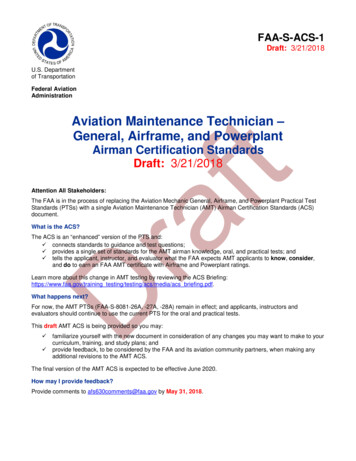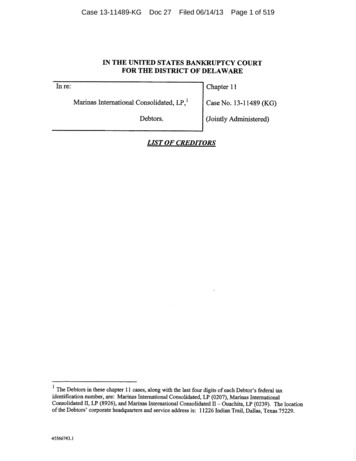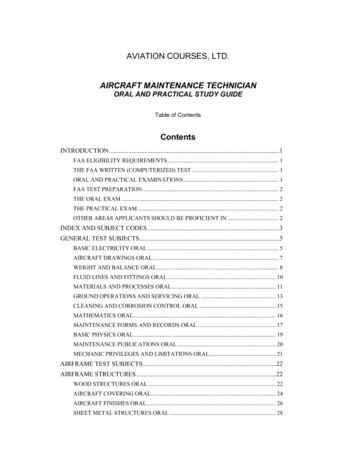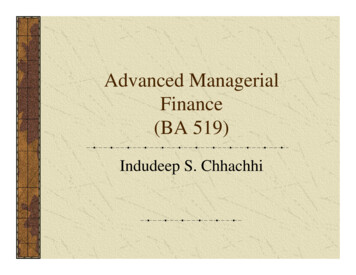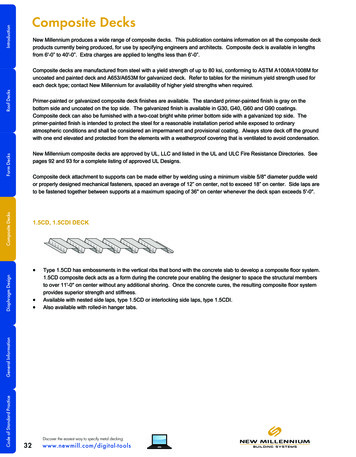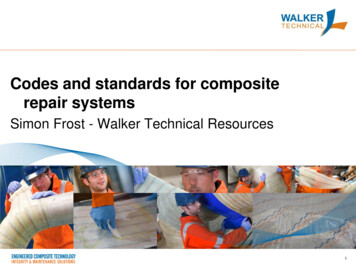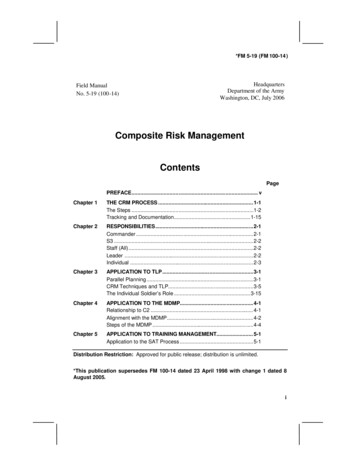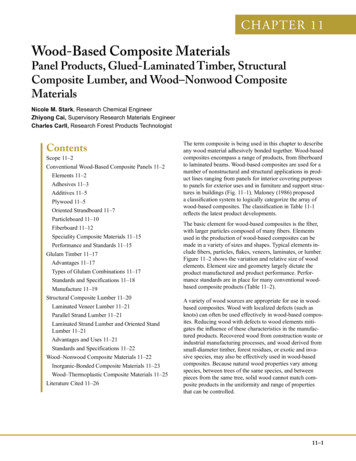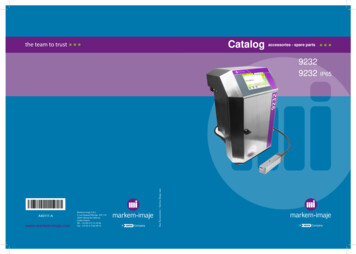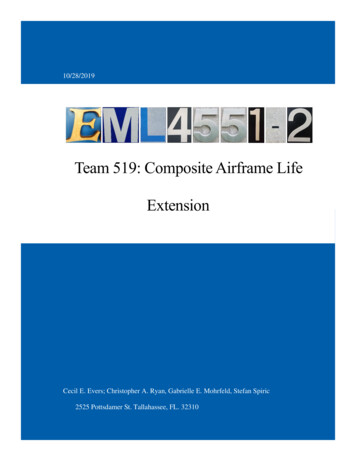
Transcription
10/28/2019Team 519: Composite Airframe LifeExtensionCecil E. Evers; Christopher A. Ryan, Gabrielle E. Mohrfeld, Stefan Spiric2525 Pottsdamer St. Tallahassee, FL. 32310Team#519iGraduation year: 2020
Chapter One: EML 4551CProject ScopeProject Description.The objective of this project is to evaluate replacing aluminum with a composite materialfor use as a C channel in an E-2 Hawkeye, by designing and performing experiments, accordingto MIL-STD-810, comparing aluminum with various composite materials.Motivation.The E-2 Hawkeye is a carrier borne airborne early warning and control (AEW&C)aircraft. The E-2 family of aircraft have been in service since the 1960s; the modern variant is theE-2D Advanced Hawkeye produced by Northrup Grumman, shown below.Figure 1: Northrup Grumman E-2D Advanced HawkeyeTeam#5191Graduation year: 2020
Naval aviation has paradoxical size and weight requirements: the aircraft need to havelarge wings to decrease landing speed on short carrier flight decks and increase handling at lowspeed; however, the aircraft also need to be as lightweight as possible. (Wikipedia, 2019)Reducing airframe weight by using composites is a worthwhile goal because it reduces the liftrequired and therefore the size of the aircraft. In addition to improving flight characteristics, theweight saved by using lighter airframe materials can be allocated towards increasing the missioncapability of the aircraft. In the case of the E-2, this could be more weight for sensory andcommunication equipment or fuel.The second principle advantage composites offer is corrosion resistance; naval aircraftare continuously exposed to a corrosive environment while deployed. A composite material mayneed less maintenance than traditional materials, reducing operation costs and increasingreadinessComposites Background.The Principle of Combined Action states that two materials with different properties canbe combined to create a composite that incorporates the best parts of each material. Mostcomposites are two phase materials with a distributed phase and a matrix phase. The distributedphase is generally a fibrous material with good tension strength which is enclosed in a matrixmaterial with good shear strength. The result is an anisotropic material which is very strong inthe direction of the fibers (the longitudinal direction) but significantly less strong in the directionperpendicular to the fiber direction (the transverse direction).Team#5192Graduation year: 2020
In figure 2a, the fibers are aligned in a single direction, resulting in an anisotropicmaterial which is very strong only in a single direction (the direction of the fibers). Figure 2b,shows fibers going in two directions, resulting in a material which is strong in two directions.Figure 2c, shows fibers which are oriented randomly, resulting in a material that isapproximately isotropic along the longitudinal and transverse planes. (Callister, 2014)Composites are categorized by the matrix phase material. A ceramic matrix would be toobrittle for a structural part of an airframe and would be far too heavy. A metal matrix would beextremely expensive and probably heavier than aluminum. This leaves polymer as the matrixmaterial of choice. Polymer composites are extremely light, offer superior mechanical properties,and are used extensively in new airframe design. (Hale, 2006)The distributed phase of polymer matrix composites are generally aramid fibers, glassfibers, or carbon fibers. Each type of fiber has a different use; carbon fibers see the most use inaerospace components; this family of composites are called Carbon Fiber Reinforced Polymers(CFRP). A more detailed discussion of distributed phase materials will occur later.C Channel Background.The C channel is a structural beam that is designed to hold a load. The C channel consistsof two flanges attached to a web that allows for greater strength in bending. These structuralchannels have many applications, including in the airframes for many aircraft. These C channelsTeam#5193Graduation year: 2020
can be manufactured from a variety of materials including steel and aluminum. These beamscome in many standard sizes with varying cross-sectional dimensions and lengths. The back sideof the web can often be mounted onto other structures. Two identical C channels may also bemounted back to back in order to form an I beam. Since developing a mold for composite Ibeams could be difficult, it common two see two composite C channels mounted back to back.Insert a picture of it.The governing equations are: bending y, bending x, moments of inertia, neutral axis. Itsmeant to be loaded in bending y because the most material is placed in the areas of highest stress.Explain St. Vennants principle and how tension will depend primarily on the attachment methodsKey Goals.The key goals of this project are to find a lightweight composite material to replace analuminum C channel with. From here, the phrase “the part” will be used in reference to the Cchannel. The team will validate the composite as structurally sound with at least five types oftests. The part holds a load and contributes to the structural rigidity of the airframe in general.Team#5194Graduation year: 2020
Determine Forces.The stresses on the part must be determined so that the team can design the best material.The stresses will be determined by running a finite element analysis (FEA) on the part along withthe governing equations. The FEA will show the areas of highest stress, which will be used todetermine the most important tests to run and to design a composite system that will beappropriate to replace aluminum with.Design Composite System.Design a composite system that will withstand the stresses required, fulfills customerrequirements, and is within the team’s budget. The team will select the materials and design acustom composite system. This will include material selection and the design of the part. Thecomposite system will be tested via FEA before manufacturing of test specimens.Down-Select MIL-STD.MIL-STD-810 details the environmental test methods for materials used by theDepartment of Defense (Department of Defense, 2019). There are far too many tests for the teamto perform, so a small number of tests will be selected which will be tailored to the specificrequirements of the part, as shown by the FEA. These tests will reflect the likely failure modes ofcomposites and the operating conditions of the part. The tests the team runs will be heavilyinfluenced by the team’s budget and facility availability.Perform Tests.The team will design and perform a series of tests which will replicate maximum loadingconditions of the part, as revealed by the FEA. All tests are to be done in accordance with MILSTD-810 and any relevant ASTM standards.Team#5195Graduation year: 2020
Analyze Results.Compare test results with values for aluminum alloys to determine if a composite will bea suitable replacement. Consider not just the mechanical properties, but also secondaryadvantages and disadvantages of composites. Also consider cost benefit of replacing aluminumwith composite. Make a recommendation for further integration of composites into airframes.Markets.There are many applications of the techniques developed in this project.Department of Defense.Both the United States Navy and the United States Air Force are interested in replacingthe aluminum and other airframe materials with composite components. (Milberg, 2015)Composites can offer superior strength, lifespan, electromagnetic properties, and weight savings.Aerospace Companies.Civilian aviation companies are also integrating composites in airframes, most notablythe Boeing 787, which is 50% composite material. (Hale, 2006) The primary advantagecomposites offer in civilian aviation is fewer maintenance hours than aluminum, which meansmore profitable flight hours and less time grounded.Secondary Markets.Many allied militaries purchase systems from the US or develop their own systems. Theymay decide to use composite materials in the airframes of their aircraft as well.Replacing metals with composites also has applications in the automobile industry wherelighter cars will lead to fuel savings for the consumer. Not only are composites attractive becauseof their low weight, they can also offer more resilience than traditional metal parts.Team#5196Graduation year: 2020
Assumptions.Several key assumptions are made to limit the possible scope of the project. It is assumedthat part is to be mounted in an E-2D Advanced Hawkeye; the validation done on the compositematerial are assumed to reflect the specific operating conditions of this aircraft. The sponsor,Northrup Grumman, will be asked to provide information regarding the amount of force exertedon the part, the operating temperature of the part, vibration profiles, etc. If this informationcannot be provided, the details in question will be studied further and assumed values will beassigned.The two primary constraints on the project are budget and timeline. The project will beconstrained by the delivery timeline. The available budget will be set at 2000. Theseassumptions are the primary limitations of the project scope and timeline. Under no circumstancewill the project be allowed to surpass either of these constraints.It is assumed that the facilities at the College of Engineering will be available to testspecimens. In addition, these facilities need to perform the tests that are necessary to completethe selected tests. This assumption limits the possible scope of the project to only tests that canbe done on campus, and within the team’s budget. The team may be able to use facilities at theHigh-Performance Materials Institute (HPMI).It is assumed that the test specimens obtained are reflective of the components used forthe prototype. These specimens are assumed to behave in the same manner and have the samephysical properties as the materials used in a full-scale prototype.Team#5197Graduation year: 2020
Stakeholders.A stakeholder is anyone who has control, interest, or an investment in the project. Thismay be expressed as authority over the members of the project group, time allocated to theproject in assisting the members of the project group, or financial investment in the project itself,among other things.Northrop Grumman, Project Sponsor.Northrop Grumman Corporation (NGC) sponsors the project; they invest time and moneyinto the project and receive the product in the end. NGC has provided mentors to help guide theproject.Dr. Shayne McConomy, Senior Design Project Coordinator.Dr. McConomy grades the deliverables for the project and will grade the student’sperformance in the Senior Design class. Along with the sponsor, Dr. McConomy invests timeand can control the project in relation to what is required for the Senior Design course.Dr. Lance Cooley, Faculty Technical Advisor.Dr. Cooley is the faculty advisor for the project; he is interested in the success of theteam. Dr. Cooley invests his time with the team by meeting with them on a biweekly basis andproviding mentorship.United States Navy.The USN is the primary operator of the E-2, and it is also operated by other alliedcountries. The navy wants the lightest planes possible to catapult off of and land on carrierdecks. Additionally, maintenance is more difficult on a ship, so a more durable part that requiresless maintenance will lead to higher operational readiness rates and lower long-term cost.Team#5198Graduation year: 2020
United States Airforce.The USAF is currently interested in switching out aluminum components for compositein many aircraft. Many airframes are undergoing life extension programs, and new designs makeextensive use of composites. The Air Force Research Lab issued the Composite Airframe LifeExtension (CALE) grant that this project is based off. (Air Force Research Lab, 2015)High Performance Materials Institute.HPMI is a multidisciplinary research institute at Florida State University with a primarytechnology research area in high-performance composite materials. Dr. Hao has graciouslyoffered her expertise and facility access to the team.Team#5199Graduation year: 2020
to MIL-STD-810, comparing aluminum with various composite materials. Motivation. The E-2 Hawkeye is a carrier borne airborne early warning and control (AEW&C) aircraft. The E-2 family of aircraft have been in service since the 1960s; the modern variant is the E-2D Ad

